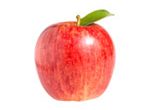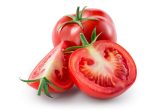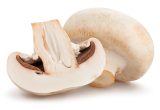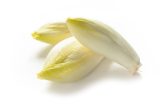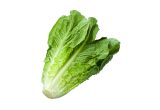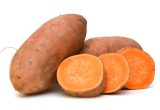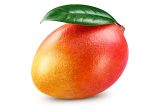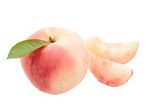Cabbage (green)

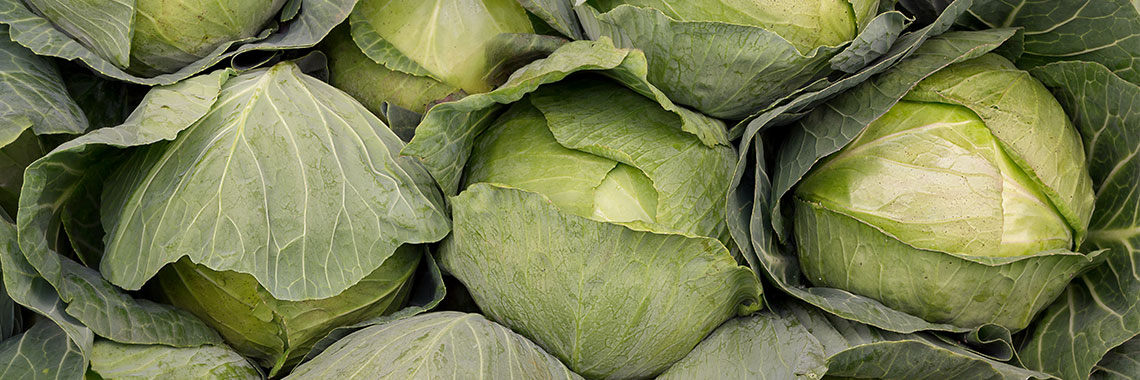
Description
- Green cabbage (Brassica oleracea var. capitata), also called simply cabbage, belongs to the Brassicaceae family (cruciferous plants).
- It is one of the six most widely cultivated subspecies of Brassica oleacea worldwide (Kim, 2014).
- It is a biennial herbaceous plant native to southern and western Europe (Carvalho, 2011).
PHYSICAL AND ORGANOLEPTIC CHARACTERISTICS
- Cabbage can be red, green or white in colour, all three have the same scientific name (Brassica oleracea var. capitata).
- Green cabbage is a vegetable with green coloured leaves and is characterised by a short stem on which the leaf is crowded (Kim, 2014).
- Green cabbage contains chlorophyll, a pigment that is mainly found in green plants (Marangoni, 2017).
- Brassicaceous plants are known for their predominantly bitter taste and sulphurous, pungent aroma. The compounds responsible for these sensations comprise glucosinolates (GSL) including glucobrassicin/neoglucobrassicin, and their hydrolysis products, isothiocyanates (ITC), but also other volatile sulphur compounds (Bell, 2018).
COMPOSITION CHARACTERISTICS (excluding macronutrients, vitamins and minerals)
- Green cabbage has a lower concentration of phenolic compounds than red cabbage and Chinese white cabbage, but a higher concentration than Chinese cabbage and mustard cabbage (Lee, 2007).
- Green cabbage is a source of folic acid, vitamins (e.g., C and K), and polyphenols, including flavonoids (Gerszberg, 2018; Mabuchi, 2019). In addition, it contains glucosinolates, secondary metabolites and amino acids, which contribute to its anti-inflammatory and anti-cancer properties (Gerszberg, 2018).
- Among the glucosinolates, glucobrassicin/neoglucobrassicin is reported to have anti-cancer properties, particularly for prostate cancer (Bell, 2018).
- ITCs in green cabbage are reported to exhibit anti-carcinogenic activity and chemoprotective mechanisms and prevent cardiovascular and neurodegenerative disorders (Bell, 2018; Mithen, 2018).
- In green cabbage, fructose, glucose and glucosinolate contents of the inner layers are reportedly significantly higher than those of the outer layers. However, the amount of secondary metabolites (carotenoids, vitamin C, anthocyanins, flavonoids and total phenolic compounds) and proteins are reportedly higher in the outer leaves (Zhao, 2020).
RAW
The following values are approximate and depend on variety, season, ripeness, cultivation conditions, etc.
Raw green cabbage is low in energy* as it provides an average of 29 calories (kcal) per 100 g, i.e. 121 kJ. One green cabbage weighs on average 2 kg.
COMPOSITION TABLES
For each nutrient, the tables provide information on the content, minimum and maximum values and the percentage of the Dietary Reference Values (DRVs) per 100 g net of raw green cabbage.
*Regulation (EC) No 1924/2006 of the European Parliament and of the Council of 20 December 2006 on nutrition and health claims made on foods.
MACRONUTRIENTS
| Constituent (g) | Average content |
Min-Max per 100g |
DRV% |
|---|---|---|---|
| Water | 91,80 | 89,40 - 94,20 | - |
| Fibers | 3,08 | 1,40 - 4,20 | - |
| Carbohydrates | 1,92 | NC - 3 | 0,74 |
| Sugars | 1,92 | 1,10 - 3,20 | 2,13 |
| Lipids | 0,41 | 0 - 0,90 | 0,59 |
| Saturated fat | 0,054 | 0,013 - 0,10 | 0,27 |
| Protein | 2,53 | 0,20 - 4,30 | 5,06 |
| Constituent (g) | Amount | Min-Max | DRV% |
|---|---|---|---|
| Water | Ciqual 2020 | - | - |
| Fibers | Ciqual 2020 | - | - |
| Carbohydrates | Ciqual 2020 | - | Règlement (UE) N°1169/2011 du parlement Européen et du conseil du 25 octobre 2011 |
| Sugars | Ciqual 2020 | - | Règlement (UE) N°1169/2011 du parlement Européen et du conseil du 25 octobre 2011 |
| Lipids | Ciqual 2020 | - | Règlement (UE) N°1169/2011 du parlement Européen et du conseil du 25 octobre 2011 |
| Saturated fat | Ciqual 2020 | - | Règlement (UE) N°1169/2011 du parlement Européen et du conseil du 25 octobre 2011 |
| Protein | Ciqual 2020 | - | Règlement (UE) N°1169/2011 du parlement Européen et du conseil du 25 octobre 2011 |
Zoom on carbohydrates
- The carbohydrate content of raw green cabbage (1.92 g per 100 g) is well below the average amount found in raw vegetables (4.45 g per 100 g).
- Raw green cabbage is low in sugar* (1.92 g per 100 g) as it contains no more than 5 g per 100 g.
Zoom on fibres
- Raw green cabbage is a source of fibre* as it provides more than 3 g per 100 g, i.e. 3.08 g per 100 g.
- This amount of fibre is higher than the average quantity found in raw vegetables (2.43 g per 100 g).
Zoom on proteins
- The protein content of raw green cabbage (2.53 g per 100 g) is higher than the average amount found in raw vegetables (1.87 g per 100 g).
Zoom on lipids
- The fat content of raw green cabbage (0.41 g per 100 g) is lower than the average amount found in raw vegetables (0.56 g per 100 g).
- Raw green cabbage is fat-free* as it contains less than 0.5 g of fat per 100 g.
*Regulation (EC) No 1924/2006 of the European Parliament and of the Council of 20 December 2006 on nutrition and health claims made on foods.
MINERALS AND TRACE ELEMENTS
| Constituent | Average content |
Min-Max per 100g |
DRV% |
|---|---|---|---|
| Calcium (mg) | 96,20 | 25,20 - 212 | 12,03 |
| Chloride (mg) | - | - | - |
| Copper (mg) | 0,049 | 0 - 0,07 | 4,90 |
| Iron (mg) | 0,93 | 0,21 - 1,90 | 6,64 |
| Iodine (µg) | 0,30 | NC - 1 | 0,20 |
| Magnesium (mg) | 18 | 8,20 - 28 | 4,80 |
| Manganese (mg) | 0,17 | 0,085 - 0,44 | 8,50 |
| Phosphorus (mg) | 32,70 | 18 - 42,20 | 4,67 |
| Potassium (mg) | 231 | 130 - 288 | 11,55 |
| Selenium (µg) | 1,86 | 0,90 - 6,19 | 3,38 |
| Sodium (mg) | 25,80 | 3,20 - 40 | - |
| Zinc (mg) | 0,22 | 0,09 - 0,41 | 2,20 |
| Constituent | Amount | Min-Max | DRV% |
|---|---|---|---|
| Calcium (mg) | Ciqual 2020 | - | Règlement (UE) N°1169/2011 du parlement Européen et du conseil du 25 octobre 2011 |
| Chloride (mg) | Ciqual 2020 | - | Règlement (UE) N°1169/2011 du parlement Européen et du conseil du 25 octobre 2011 |
| Copper (mg) | Ciqual 2020 | - | Règlement (UE) N°1169/2011 du parlement Européen et du conseil du 25 octobre 2011 |
| Iron (mg) | Ciqual 2020 | - | Règlement (UE) N°1169/2011 du parlement Européen et du conseil du 25 octobre 2011 |
| Iodine (µg) | Ciqual 2020 | - | Règlement (UE) N°1169/2011 du parlement Européen et du conseil du 25 octobre 2011 |
| Magnesium (mg) | Ciqual 2020 | - | Règlement (UE) N°1169/2011 du parlement Européen et du conseil du 25 octobre 2011 |
| Manganese (mg) | Ciqual 2020 | - | Règlement (UE) N°1169/2011 du parlement Européen et du conseil du 25 octobre 2011 |
| Phosphorus (mg) | Ciqual 2020 | - | Règlement (UE) N°1169/2011 du parlement Européen et du conseil du 25 octobre 2011 |
| Potassium (mg) | Ciqual 2020 | - | Règlement (UE) N°1169/2011 du parlement Européen et du conseil du 25 octobre 2011 |
| Selenium (µg) | Ciqual 2020 | - | Règlement (UE) N°1169/2011 du parlement Européen et du conseil du 25 octobre 2011 |
| Sodium (mg) | Ciqual 2020 | - | - |
| Zinc (mg) | Ciqual 2020 | - | Règlement (UE) N°1169/2011 du parlement Européen et du conseil du 25 octobre 2011 |
Zoom on minerals and trace elements
- Raw green cabbage contains significant amounts of calcium and potassium. In fact, it provides the equivalent of:
- 12.03% of DRVs for calcium, i.e. 96.20 mg per 100 g,
- 11.55% of DRVs for potassium, i.e. 231 mg per 100 g.
- The other minerals and trace elements are present in quantities representing less than 9% of DRVs.
VITAMINS
| Constituent | Average content |
Min-Max per 100g |
DRV% |
|---|---|---|---|
| Provitamin A Beta-carotene (µg) | 321 | 21 - 600 | - |
| Vitamin A equivalent (µg) | 53,50 | 3,50 - 100 | 6,69 |
| Vitamin B1 (mg) | 0,059 | 0,039 - 0,072 | 5,36 |
| Vitamin B2 (mg) | 0,039 | 0,03 - 0,076 | 2,79 |
| Vitamin B3 (mg) | 0,26 | 0,037 - 0,42 | 1,63 |
| Vitamin B5 (mg) | 0,17 | 0,14 - 0,23 | 2,83 |
| Vitamin B6 (mg) | 0,15 | 0,085 - 0,21 | 10,71 |
| Vitamin B9 (µg) | 67,9 | 43 - 80 | 33,95 |
| Vitamin C (mg) | 69 | 29,20 - 105 | 86,25 |
| Vitamin E (mg) | 0,16 | 0,08 - 0,27 | 1,33 |
| Vitamin K1 (µg) | 121 | 56,60 - 170 | 161,33 |
| Constituent | Amount | Min-Max | DRV% |
|---|---|---|---|
| Provitamin A Beta-carotene (µg) | Ciqual 2020 | - | - |
| Vitamin A equivalent (µg) | Calcul à partir de la valeur Provitamine A Béta-carotène* | - | Règlement (UE) N°1169/2011 du parlement Européen et du conseil du 25 octobre 2011 |
| Vitamin B1 (mg) | Ciqual 2020 | - | Règlement (UE) N°1169/2011 du parlement Européen et du conseil du 25 octobre 2011 |
| Vitamin B2 (mg) | Ciqual 2020 | - | Règlement (UE) N°1169/2011 du parlement Européen et du conseil du 25 octobre 2011 |
| Vitamin B3 (mg) | Ciqual 2020 | - | Règlement (UE) N°1169/2011 du parlement Européen et du conseil du 25 octobre 2011 |
| Vitamin B5 (mg) | Ciqual 2020 | - | Règlement (UE) N°1169/2011 du parlement Européen et du conseil du 25 octobre 2011 |
| Vitamin B6 (mg) | Ciqual 2020 | - | Règlement (UE) N°1169/2011 du parlement Européen et du conseil du 25 octobre 2011 |
| Vitamin B9 (µg) | Ciqual 2020 | - | Règlement (UE) N°1169/2011 du parlement Européen et du conseil du 25 octobre 2011 |
| Vitamin C (mg) | Ciqual 2020 | - | Règlement (UE) N°1169/2011 du parlement Européen et du conseil du 25 octobre 2011 |
| Vitamin E (mg) | Ciqual 2020 | - | Règlement (UE) N°1169/2011 du parlement Européen et du conseil du 25 octobre 2011 |
| Vitamin K1 (µg) | Ciqual 2020 | - | Règlement (UE) N°1169/2011 du parlement Européen et du conseil du 25 octobre 2011 |
Zoom on vitamins
- Raw green cabbage is high in:
- vitamin K1 as it provides the equivalent of 161.33% of DRVs, i.e. 121 µg per 100 g;
- vitamin C as it provides the equivalent of 86.25% of DRVs, i.e. 69 mg per 100 g;
- vitamin B9 as it provides the equivalent of 33.95% of DRVs, i.e. 67.90 µg per 100 g.
- Raw green cabbage also contains a significant amount of vitamin B6 with a content equivalent to 10.71% of DRVs, i.e. 0.15 mg per 100 g.
- The other vitamins are present in raw green cabbage in quantities representing less than 7% of DRVs.
*Calculation made: Beta-Carotene / 6 + retinol
POLYPHENOLS
Constituent
(mg)
Average content
Min-Max
per 100mg
Flavonoids
(mg)
0,04
0 - 0,19
of which
Flavonols
(mg)
0,04
0 - 0,19
Lignanes
(mg)
0,08
0,07 - 0,08
Total polyphenols
0,12
0,07 - 0,27
Constituent
(mg)
Amount
Min-Max
Flavonoids
Phenol explorer Version 3.6 Méthode utilisée : Chromatographie après hydrolyse
-
of which
Flavonols
Phenol explorer Version 3.6 Méthode utilisée : Chromatographie après hydrolyse
-
Lignanes
Phenol explorer Version 3.6 Méthode utilisée : Chromatographie après hydrolyse
-
Total polyphenols
Phenol explorer Version 3.6 Méthode utilisée : Chromatographie après hydrolyse
-
Zoom on polyphenols
- Polyphenols are substances with an antioxidant effect.
- The polyphenols in raw green cabbage are mainly lignans.
BOILED
The following values are approximate and depend on variety, season, ripeness, cultivation conditions, etc.
Boiled green cabbage is low in energy* as it provides an average of 21.60 calories (kcal) per 100 g, i.e. 90 kJ. One green cabbage weighs on average 2 kg.
COMPOSITION TABLE
For each nutrient, the tables provide information on the content, minimum and maximum values and percentage of the Dietary Reference Values (DRVs) per 100 g net of green cabbage, boiled/cooked in water.
*Regulation (EC) No 1924/2006 of the European Parliament and of the Council of 20 December 2006 on nutrition and health claims made on foods.
MACRONUTRIENTS
| Constituent (g) | Average content |
Min-Max per 100g |
DRV% |
|---|---|---|---|
| Water | 92,70 | - | - |
| Fibers | 3,30 | - | - |
| Carbohydrates | 1,83 | NC - 1,84 | 0,70 |
| Sugars | 1,40 | - | 1,56 |
| Lipids | < 0,30 | - | - |
| Saturated fat | < 0,01 | - | - |
| Protein | 1,63 | 1,60 - NC | 3,26 |
| Constituent (g) | Amount | Min-Max | DRV% |
|---|---|---|---|
| Water | Ciqual 2020 (valeur issue des analyses Ciqual-Aprifel 2018) | - | - |
| Fibers | Ciqual 2020 (valeur issue des analyses Ciqual-Aprifel 2018) | - | - |
| Carbohydrates | Ciqual 2020 | - | Règlement (UE) N°1169/2011 du parlement Européen et du conseil du 25 octobre 2011 |
| Sugars | Ciqual 2020 (valeur issue des analyses Ciqual-Aprifel 2018) | - | Règlement (UE) N°1169/2011 du parlement Européen et du conseil du 25 octobre 2011 |
| Lipids | Ciqual 2020 (valeur issue des analyses Ciqual-Aprifel 2018) | - | Règlement (UE) N°1169/2011 du parlement Européen et du conseil du 25 octobre 2011 |
| Saturated fat | Ciqual 2020 (valeur issue des analyses Ciqual-Aprifel 2018) | - | Règlement (UE) N°1169/2011 du parlement Européen et du conseil du 25 octobre 2011 |
| Protein | Ciqual 2020 (valeur issue des analyses Ciqual-Aprifel 2018) | - | Règlement (UE) N°1169/2011 du parlement Européen et du conseil du 25 octobre 2011 |
Zoom on carbohydrates
- The carbohydrate content (1.83 g per 100 g) is lower than the average amount found in cooked vegetables (4.85 g per 100 g).
- They are mainly in the form of glucose (0.70 g per 100 g), fructose (0.50 g per 100 g) and sucrose (0.20 g per 100 g).
- Boiled green cabbage is low in sugar* (1.40 g per 100 g) as it contains no more than 5 g per 100 g.
Zoom on fibres
- Boiled green cabbage is a source of fibre* as it contains more than 3 g of fibre per 100 g, i.e. 3.30 g per 100 g.
- This amount is higher than the average quantity found in cooked vegetables (2.89 g per 100 g).
Zoom on proteins
- The protein content of boiled green cabbage (1.63 g per 100 g) is lower than the average amount found in cooked vegetables (2 g per 100 g).
Zoom on lipids
- Boiled green cabbage is fat-free* as it contains less than 0.5 g of fat per 100 g.
*Regulation (EC) No 1924/2006 of the European Parliament and of the Council of 20 December 2006 on nutrition and health claims made on foods.
MINERALS AND TRACE ELEMENTS
| Constituent | Average content |
Min-Max per 100g |
DRV% |
|---|---|---|---|
| Calcium (mg) | 48 | - | 6 |
| Chloride (mg) | < 20 | - | - |
| Copper (mg) | 0,11 | - | 11 |
| Iron (mg) | 0,34 | - | 2,43 |
| Iodine (µg) | < 20 | - | - |
| Magnesium (mg) | 7,30 | - | 1,95 |
| Manganese (mg) | 0,11 | - | 5,50 |
| Phosphorus (mg) | 29 | - | 4,14 |
| Potassium (mg) | 130 | - | 6,50 |
| Selenium (µg) | < 20 | - | - |
| Sodium (mg) | 5 | - | - |
| Zinc (mg) | 0,13 | - | 1,30 |
| Constituent | Amount | Min-Max | DRV% |
|---|---|---|---|
| Calcium (mg) | Ciqual 2020 (valeur issue des analyses Ciqual-Aprifel 2018) | - | Règlement (UE) N°1169/2011 du parlement Européen et du conseil du 25 octobre 2011 |
| Chloride (mg) | Ciqual 2020 (valeur issue des analyses Ciqual-Aprifel 2018) | - | Règlement (UE) N°1169/2011 du parlement Européen et du conseil du 25 octobre 2011 |
| Copper (mg) | Ciqual 2020 (valeur issue des analyses Ciqual-Aprifel 2018) | - | Règlement (UE) N°1169/2011 du parlement Européen et du conseil du 25 octobre 2011 |
| Iron (mg) | Ciqual 2020 (valeur issue des analyses Ciqual-Aprifel 2018) | - | Règlement (UE) N°1169/2011 du parlement Européen et du conseil du 25 octobre 2011 |
| Iodine (µg) | Ciqual 2020 (valeur issue des analyses Ciqual-Aprifel 2018) | - | Règlement (UE) N°1169/2011 du parlement Européen et du conseil du 25 octobre 2011 |
| Magnesium (mg) | Ciqual 2020 (valeur issue des analyses Ciqual-Aprifel 2018) | - | Règlement (UE) N°1169/2011 du parlement Européen et du conseil du 25 octobre 2011 |
| Manganese (mg) | Ciqual 2020 (valeur issue des analyses Ciqual-Aprifel 2018) | - | Règlement (UE) N°1169/2011 du parlement Européen et du conseil du 25 octobre 2011 |
| Phosphorus (mg) | Ciqual 2020 (valeur issue des analyses Ciqual-Aprifel 2018) | - | Règlement (UE) N°1169/2011 du parlement Européen et du conseil du 25 octobre 2011 |
| Potassium (mg) | Ciqual 2020 (valeur issue des analyses Ciqual-Aprifel 2018) | - | Règlement (UE) N°1169/2011 du parlement Européen et du conseil du 25 octobre 2011 |
| Selenium (µg) | Ciqual 2020 (valeur issue des analyses Ciqual-Aprifel 2018) | - | Règlement (UE) N°1169/2011 du parlement Européen et du conseil du 25 octobre 2011 |
| Sodium (mg) | Ciqual 2020 (valeur issue des analyses Ciqual-Aprifel 2018) | - | - |
| Zinc (mg) | Ciqual 2020 (valeur issue des analyses Ciqual-Aprifel 2018) | - | Règlement (UE) N°1169/2011 du parlement Européen et du conseil du 25 octobre 2011 |
Zoom on minerals and trace elements
- Boiled green cabbage contains a significant amount of copper. It represents 11% of copper DRVs, i.e. 0.11 mg per 100 g.
- The other minerals and trace elements are present in quantities representing less than 7% of DRVs.
VITAMINS
| Constituent | Average content |
Min-Max per 100g |
DRV% |
|---|---|---|---|
| Provitamin A Beta-carotene (µg) | 130 | - | - |
| Vitamin A equivalent (µg) | 21,67 | - | 2,71 |
| Vitamin B1 (mg) | 0,02 | - | 1,82 |
| Vitamin B2 (mg) | < 0,01 | - | - |
| Vitamin B3 (mg) | < 0,10 | - | - |
| Vitamin B5 (mg) | 0,078 | - | 1,30 |
| Vitamin B6 (mg) | 0,052 | - | 3,71 |
| Vitamin B9 (µg) | 12,40 | - | 6,20 |
| Vitamin C (mg) | 12 | - | 15 |
| Vitamin E (mg) | < 0,08 | - | - |
| Vitamin K1 (µg) | 9,77 | - | 13,03 |
| Constituent | Amount | Min-Max | DRV% |
|---|---|---|---|
| Provitamin A Beta-carotene (µg) | Ciqual 2020 (valeur issue des analyses Ciqual-Aprifel 2018) | - | - |
| Vitamin A equivalent (µg) | Calcul à partir de la valeur Provitamine A Béta-carotène* | - | Règlement (UE) N°1169/2011 du parlement Européen et du conseil du 25 octobre 2011 |
| Vitamin B1 (mg) | Ciqual 2020 (valeur issue des analyses Ciqual-Aprifel 2018) | - | Règlement (UE) N°1169/2011 du parlement Européen et du conseil du 25 octobre 2011 |
| Vitamin B2 (mg) | Ciqual 2020 (valeur issue des analyses Ciqual-Aprifel 2018) | - | Règlement (UE) N°1169/2011 du parlement Européen et du conseil du 25 octobre 2011 |
| Vitamin B3 (mg) | Ciqual 2020 (valeur issue des analyses Ciqual-Aprifel 2018) | - | Règlement (UE) N°1169/2011 du parlement Européen et du conseil du 25 octobre 2011 |
| Vitamin B5 (mg) | Ciqual 2020 (valeur issue des analyses Ciqual-Aprifel 2018) | - | Règlement (UE) N°1169/2011 du parlement Européen et du conseil du 25 octobre 2011 |
| Vitamin B6 (mg) | Ciqual 2020 (valeur issue des analyses Ciqual-Aprifel 2018) | - | Règlement (UE) N°1169/2011 du parlement Européen et du conseil du 25 octobre 2011 |
| Vitamin B9 (µg) | Ciqual 2020 (valeur issue des analyses Ciqual-Aprifel 2018) | - | Règlement (UE) N°1169/2011 du parlement Européen et du conseil du 25 octobre 2011 |
| Vitamin C (mg) | Ciqual 2020 (valeur issue des analyses Ciqual-Aprifel 2018) | - | Règlement (UE) N°1169/2011 du parlement Européen et du conseil du 25 octobre 2011 |
| Vitamin E (mg) | Ciqual 2020 | - | Règlement (UE) N°1169/2011 du parlement Européen et du conseil du 25 octobre 2011 |
| Vitamin K1 (µg) | Ciqual 2020 (valeur issue des analyses Ciqual-Aprifel 2018) | - | Règlement (UE) N°1169/2011 du parlement Européen et du conseil du 25 octobre 2011 |
Zoom on vitamins
- Boiled green cabbage is a source of vitamin C as it provides the equivalent of 15% of DRVs, i.e. 12 mg per 100 g.
- It also provides a significant amount of vitamin K1 as it represents 13.03% of DRVs, i.e. 9.77 µg per 100 g.
- The other vitamins are present in quantities representing less than 7% of DRVs.
*Calculation made: Beta-Carotene / 6 + retinol
POLYPHENOLS
Nutrition and health claims
According to the definitions of nutrition claims as set out in Regulation (EC) No 1924/2006 on nutrition and health claims, and in view of the composition of raw green cabbage, the following claims may be used:
NUTRITION CLAIMS OF RAW GREEN CABBAGE
- Low in energy (100 g of raw green cabbage provide less than 40 kcal)
- Fat-free (100 g of raw green cabbage contain no more than 0.5 g of fat)
- Low in sugar (100 g of raw green cabbage contain no more than 5 g of sugars)
- High in vitamin K1 (100 g of raw green cabbage provide the equivalent of more than 30% of DRVs)
- High in vitamin C (100 g of raw green cabbage provide the equivalent of more than 30% of DRVs)
- High in vitamin B9 (100 g of raw green cabbage provide the equivalent of more than 30% of DRVs)
- Source of fibre (100 g of raw green cabbage provide more than 3 g of fibre)
HEALTH CLAIMS (for a consumption of 100 g of raw green cabbage)
Vitamin K1
- Vitamin K1 contributes to:
- maintenance of normal bones,
- normal blood clotting.
Vitamin C
- Vitamin C contributes to:
- normal function of the immune system during and after intense physical exercise,
- normal collagen formation for the normal function of blood vessels,
- normal collagen formation for the normal function of bones,
- normal collagen formation for the normal function of cartilage,
- normal collagen formation for the normal function of gums,
- normal collagen formation for the normal function of skin,
- normal collagen formation for the normal function of teeth,
- normal energy-yielding metabolism,
- normal functioning of the nervous system,
- normal psychological function,
- normal function of the immune system,
- protection of cells from oxidative stress,
- reduction of tiredness and fatigue,
- regeneration of the reduced form of vitamin E.
- Vitamin C increases iron absorption.
Folates or vitamin B9
- Folates contribute to:
- maternal tissue growth during pregnancy,
- normal amino acid synthesis,
- normal blood formation,
- normal homocysteine metabolism,
- normal psychological function,
- normal function of the immune system,
- reduction of tiredness and fatigue.
- Folates have a role in the process of cell division.
Nutrition and health claims
According to the definitions of nutrition claims as set out in Regulation (EC) No 1924/2006 on nutrition and health claims, and in view of the composition of boiled green cabbage, the following claims may be used:
NUTRITION CLAIMS OF BOILED GREEN CABBAGE
- Low in energy (100 g of boiled green cabbage provide less than 40 kcal)
- Fat-free (100 g of boiled green cabbage contain no more than 0.5 g of fat)
- Low in sugar (100 g of boiled green cabbage contain no more than 5 g of sugars)
- Source of vitamin C (100 g of boiled green cabbage provide 15% of DRVs)
- Source of fibre (100 g of boiled green cabbage provide more than 3 g of fibre)
HEALTH CLAIMS (for a consumption of 100 g of boiled green cabbage)
Vitamin C
- Vitamin C contributes to:
- normal function of the immune system during and after intense physical exercise,
- normal collagen formation for the normal function of blood vessels,
- normal collagen formation for the normal function of bones,
- normal collagen formation for the normal function of cartilage,
- normal collagen formation for the normal function of gums,
- normal collagen formation for the normal function of skin,
- normal collagen formation for the normal function of teeth,
- normal energy-yielding metabolism,
- normal functioning of the nervous system,
- normal psychological function,
- normal function of the immune system,
- protection of cells from oxidative stress,
- reduction of tiredness and fatigue,
- regeneration of the reduced form of vitamin E.
- Vitamin C increases iron absorption.
References
- Agence nationale de sécurité sanitaire de l’alimentation, de l’environnement et du travail. Table de composition nutritionnelle des aliments Ciqual 2020. Consultée le 19/08/2020 depuis le site internet Ciqual https://ciqual.anses.fr/
- Agence nationale de sécurité sanitaire de l’alimentation, de l’environnement et du travail. Table de composition nutritionnelle des aliments Ciqual pour le calcul des apports nutritionnels CALNUT 2020. Consultée le 17/09/2020 depuis le site internet Ciqual https://ciqual.anses.fr/
- Bell L, Oloyede OO, Lignou S, Wagstaff C, Methven L. Taste and Flavor Perceptions of Glucosinolates, Isothiocyanates, and Related Compounds. Molecular Nutrition & Food Research. 2018;62(18): 1700990.
- Carvalho CA, Fernandes KM, Matta SL, Silva MB, Oliveira LL, Fonseca CC. Evaluation of antiulcerogenic activity of aqueous extract of Brassica oleracea var. capitata (cabbage) on Wistar rat gastric ulceration. Arq Gastroenterol. 2011;48(4):276-82.
- Gerszberg A. Tissue culture and genetic transformation of cabbage (Brassica oleracea var. capitata): an overview. Planta. 2018;248(5): 1037–48.
- Kim HA, Lim CJ, Kim S, Choe JK, Jo SH, Baek N, Kwon SY. High-throughput sequencing and de novo assembly of Brassica oleracea var. Capitata L. for transcriptome analysis. PLoS One. 2014;9(3):e92087.
- Lee WY Jr, Emmy Hainida KI, Abbe Maleyki MJ, Amin I. Antioxidant capacity and phenolic content of selected commercially available cruciferous vegetables. Malays J Nutr. 2007;13(1):71-80.
- Mabuchi R, Tanaka M, Nakanishi C, Takatani N, Tanimoto S. Analysis of Primary Metabolites in Cabbage (Brassica oleracea var. capitata) Varieties Correlated with Antioxidant Activity and Taste Attributes by Metabolic Profiling. Molecules. 2019;24(23): 4282.
- Marangoni AG (2017). Chlorophyll Degradation in Green Tissues: Olives, Cabbage and Pickles. In: Kinetic Analysis of Food Systems. Springer International Publishing : pp. 55–63.
- Mithen R, Ho E. Isothiocyanates for Human Health. Molecular Nutrition & Food Research. 2018;62(18): 1870079.
- Neveu V, Perez-Jiménez J, Vos F, Crespy V, du Chaffaut L, Mennen L, Knox C, Eisner R, Cruz J, Wishart D, Scalbert A. (2010) Phenol-Explorer: an online comprehensive database on polyphenol contents in foods. Database, doi: 10.1093/database/bap024. Full text (free access)
- Règlement (CE) N° 1924/2006 du Parlement européen et du Conseil du 20 décembre 2006 concernant les allégations nutritionnelles et de santé portant sur les denrées alimentaires.
- Règlement (UE) N°432/2012 de la Commission du 16 mai 2012 établissant une liste des allégations de santé autorisées portant sur les denrées alimentaires, autres que celles faisant référence à la réduction du risque de maladie ainsi qu’au développement et à la santé infantiles.
- Règlement (UE) n°1169/2011 du Parlement européen et du Conseil du 25 octobre 2011 concernant l’information des consommateurs sur les denrées alimentaires, modifiant les règlements (CE) n°1924/2006 et (CE) n°1925/2006 du Parlement européen et de Conseil et abrogeant la directive 87/250/CEE de la Commission, la directive 90/496/CEE du Conseil, la directive 1999/10/CE de la Commission, la directive 200/13/CE du Parlement européen et du Conseil, les directives 2002/67/CE et 2008/5/CE de la Commission et le règlement (CE) n°608/2004 de la Commission.
- Zhao Y, Yue Z, Zhong X, Lei J, Tao P, Li B. Distribution of primary and secondary metabolites among the leaf layers of headed cabbage (Brassica oleracea var. capitata).Food Chemistry. 2020;312: 126028.





